#wildlife photographer of the year 2024
Explore tagged Tumblr posts
Text

The Swarm of Life by Shane Gross (Canada) — Wildlife Photographer of the Year 2024
#nature#tadpole#shane gross#wildlife photographer of the year 2024#wildlife photography#wildlife#amphibia#Anaxyrus boreas#western toad
0 notes
Text

The Swarm of Life by Shane Gross (New Zealand) - This winning image looks under the surface layer of lily pads as a mass of western toad tadpoles swim past. Western toad tadpoles swim up from the safer depths of the lake, dodging predators and trying to reach the shallows, where they can feed. The tadpoles start becoming toads between four and 12 weeks after hatching. An estimated 99% will not survive to adulthood -Photograph: Shane Gross/2024 Wildlife Photographer of the Year
Click source for more 2024 Wildlife photographer of the Year competition winners
#aotearoa#western toad tadpoles#anura#bufonidae#anaxyrus boreas#shane gross#2024 wildlife photographer of the year winners
154 notes
·
View notes
Text
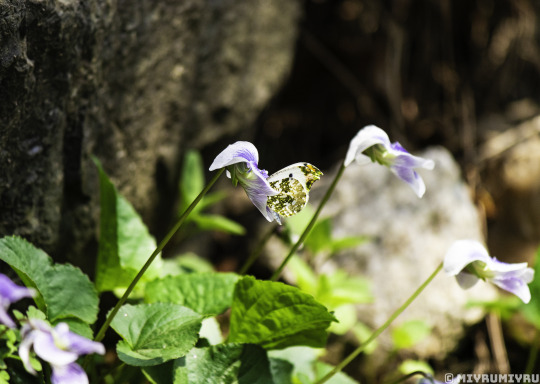
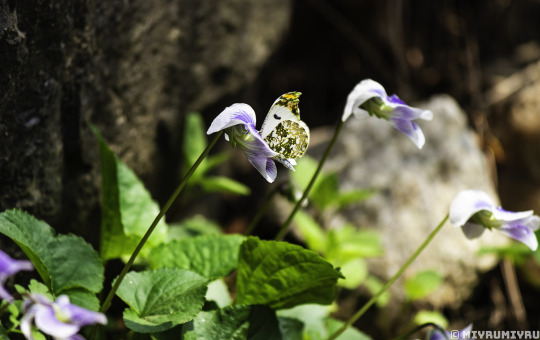

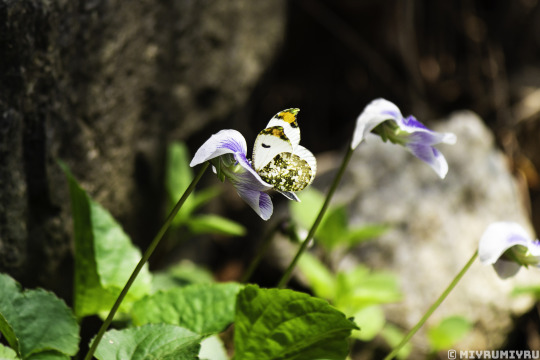


Little herald of spring! ✾(∪へ∪-)
They only appear on early spring and disappear without a trace.
(M) 갈구리나비 (Yellow tip) [Anthocharis scolymus]
Common blue violet (Viola sororia)
#photographers on tumblr#my photography#original photographers#lensblr#photography#insect photography#wildlife photography#macro photography#nature photography#nature#naturecore#insect#butterfly#pieridae#yellow tip#bugblr#biology#entomology#little angel#white angel#so tiny#so precious#they are really small#almost toenail size#see you next year little angels#april 7 2024#noai#no ai#no to generative ai
26 notes
·
View notes
Text


Little Blue Heron (Egretta caerulea)
Snowy Egret (Egretta thula)
September 6, 2024
John Heinz National Wildlife Refuge, Tinicum, Pennsylvania
I thought I had photographed several juvenile Little Blue Herons, which are white when they are young and are common at this refuge at this time of year. Was surprised to see the black legs and yellow feet of a Snowy Egret when I was editing the photos. Also the Little Blue has a two-tone bill and the Snowy's is black.
#birds#bird#photographers on tumblr#snowy egret#Egretta thula#Egretta caerulea#little blue heron#herons#egrets#birdblr#birb#birbs#ornithology#birblr#nature#animals#wildlife photography
1K notes
·
View notes
Text

The Adorable and the Fierce Star in the 2024 Wildlife Photographer of the Year Contest
551 notes
·
View notes
Text

12 June 2024
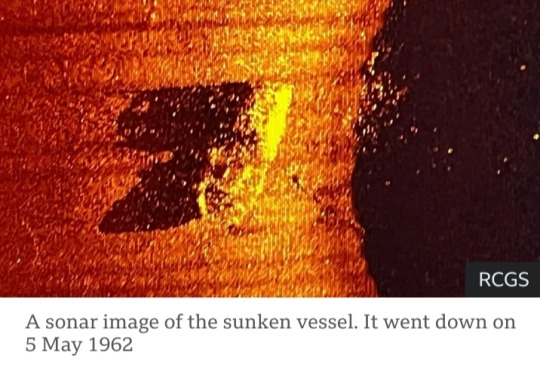
Wreck hunters have found the ship on which the famous polar explorer Ernest Shackleton made his final voyage.
The vessel, called "Quest," has been located on the seafloor off the coast of Newfoundland, Canada.
Shackleton suffered a fatal heart attack on board on 5 January 1922 while trying to reach the Antarctic.
And although Quest continued in service until it sank in 1962, the earlier link with the explorer gives it great historic significance.
The British-Irish adventurer is celebrated for his exploits in Antarctica at a time when very few people had visited the frozen wilderness.
"His final voyage kind of ended that Heroic Age of Exploration, of polar exploration, certainly in the south," said renowned shipwreck hunter David Mearns, who directed the successful search operation.
"Afterwards, it was what you would call the scientific age. In the pantheon of polar ships, Quest is definitely an icon," he told BBC News.
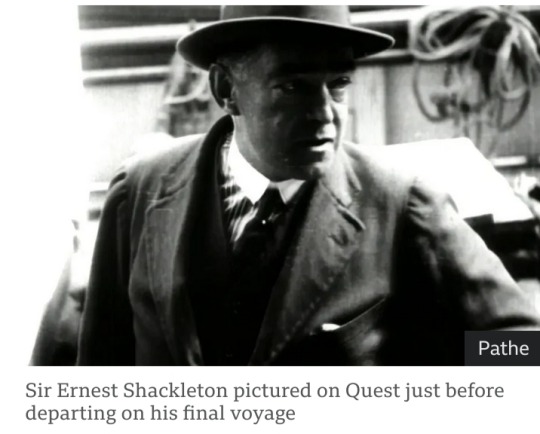
The remains of the ship, a 38m-long schooner-rigged steamship, were discovered at the bottom of the Labrador Sea on Sunday by a team led by The Royal Canadian Geographical Society (RCGS).
Sonar equipment found it in 390m (1,280ft) of water. The wreck is sitting almost upright on a seafloor that has been scoured at some point in the past by the passing of icebergs.
The main mast is broken and hanging over the port side, but otherwise, the ship appears to be broadly intact.
Quest was being used by Norwegian sealers in its last days. Its sinking was caused by thick sea-ice, which pierced the hull and sent it to the deep.
The irony, of course, is this was the exact same damage inflicted on Shackleton's Endurance - the ship he used on his ill-fated Imperial Trans-Antarctic Expedition of 1914–1917.
Fortunately, the crews of both Endurance, in 1915, and Quest, in 1962, survived.
Indeed, many of the men who escaped the Endurance sinking signed up for Shackleton's last polar mission in 1921-1922, using Quest.
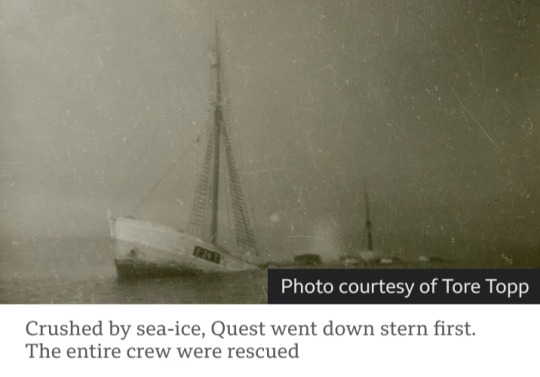
His original plan had been to explore the Arctic, north of Alaska, but when the Canadian government withdrew financial support, the expedition headed south in Quest to the Antarctic.
The new goal was to map Antarctic islands, collect specimens and look for places to install infrastructure, such as weather stations.
Shackleton never made it, however, struck down by heart failure in the Port of Grytviken on the British Overseas Territory of South Georgia, the last stop before reaching the White Continent. He was just 47 years old.
After his death, Quest was involved in other important expeditions, including the 1930-31 British Arctic Air Route Expedition led by British explorer Gino Watkins, who himself tragically died aged 25 while exploring Greenland.
Quest was also employed in Arctic rescues and served in the Royal Canadian Navy during WWII, before being turned over to the sealers.
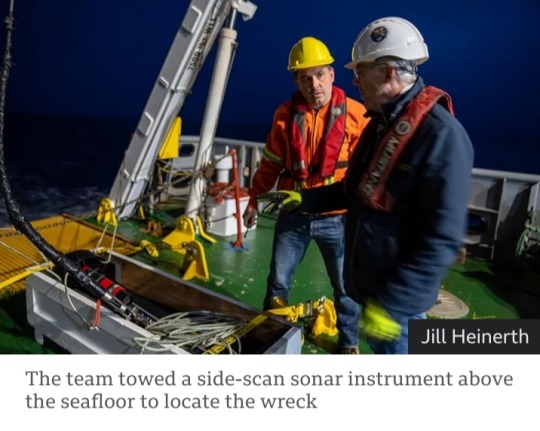
The RCGS team members carried out extensive research to find Quest's last resting place.
Information was gathered from ship's logs, navigation records, photographs, and documents from the inquiry into her loss.
The calculated sinking location in the Labrador Sea was pretty much spot on, although the exact co-ordinates are being held back for the time being.
A second visit to the wreck, possibly later this year, will do a more complete investigation.
"Right now, we don't intend to touch the wreck. It actually lies in an already protected area for wildlife, so nobody should be touching it," associate search director Antoine Normandin said.
"But we do hope to go back and photograph it with a remotely operated vehicle, to really understand its state."
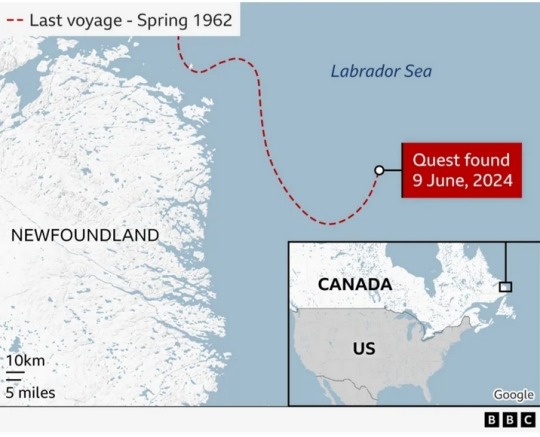
Alexandra Shackleton is the explorer's granddaughter and was patron to the RCGS survey.
"I was thrilled, really excited to hear the news; I have relief and happiness and a huge admiration for the members of the team," she told BBC News.
"For me, this represents the last discovery in the Shackleton story. It completes the circle."
The explorer continues to spark interest more than a century after his death.
Hundreds of people visit his grave on South Georgia every year to pay their respects to the man known by his crews simply as "The Boss."
"Shackleton will live forever as one of the greatest explorers of all time, not just because of what he achieved in exploration but for the way he did it, and the way he looked after his men," said David Mearns.
"His story is timeless and will be told again and again; and I'm just one of many disciples who'll keep telling it for as long as I can."
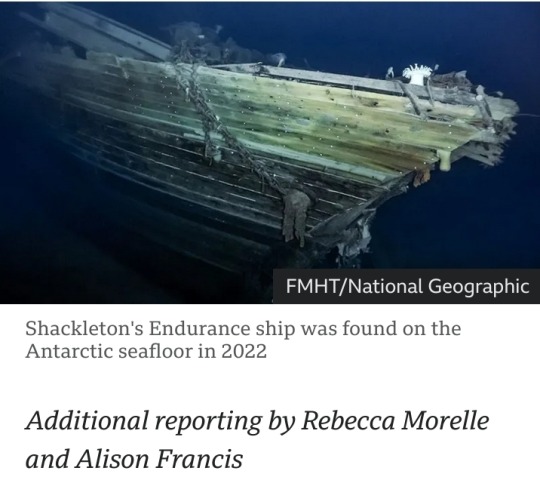
—
Sir Ernest Henry Shackleton CVO OBE FRGS FRSGS (15 February 1874 – 5 January 1922) was an Anglo-Irish Antarctic explorer who led three British expeditions to the Antarctic.
He was one of the principal figures of the period known as the Heroic Age of Antarctic Exploration.
#Ernest Shackleton#Quest#Newfoundland#Canada#Antarctic#polar explorer#shipwreck hunter#shipwreck#Labrador Sea#The Royal Canadian Geographical Society (RCGS)#Endurance#1930-31 British Arctic Air Route Expedition#Gino Watkins#sonar instrument#Heroic Age of Antarctic Exploration#Sir Ernest Henry Shackleton#British expeditions
62 notes
·
View notes
Text

Hermann Hirsch/Jan Lessman — "Swallow caught in flight above a field of cornflowers" (Wildlife Photographer of the Year People's Choice Award, 2024)
113 notes
·
View notes
Text

Clayton Harris Photography
Wildlife Photographer of the Year 2024
#art#photography#wildlife#sea#ocean#clayton harris#australia#humpback#migration#majestic#travels#whale#nature#wild animals#wild and free#power#wild life photography
44 notes
·
View notes
Text

Ryan Stalker, “Ocean Drifter.”
Goose barnacles (Thoracica), Portland, Dorset, England,
British Wildlife Photographer of the Year 2024 and Winner of Coast & Marine category.
© the photographers and British Wildlife Photographer of the Year
#art#surreal#photography#ryan stalker#pollution#ocean#drifter#portland#dorset#england#goose barnacles#wildlife#marine#underwater#british wildlife photography#marine pollution#human footprint#trash#waste
66 notes
·
View notes
Text
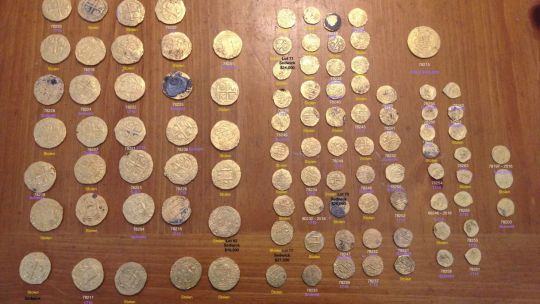
$1 Million Worth of Gold Coins Stolen From 18th-Century Shipwrecks Found
After an extensive investigation, Florida officials recovered dozens of gold coins valued at more than $1 million that were stolen from a shipwreck recovery nine years ago.
The Florida Fish and Wildlife Conservation Commission announced in a news release Tuesday it had recovered 37 gold coins that were stolen from the 1715 Fleet shipwrecks.
The fleet of Spanish ships sailed from Havana, Cuba and headed to Seville, Spain on July 24, 1715. The journey was short-lived, as a hurricane wrecked the fleet just seven days later off the coast of Eastern Florida.
The first ship was discovered in 1928 by William Beach north of Fort Pierce, Florida, about 120 miles south of Orlando. Since then, gold and silver artifacts have been recovered offshore for decades following the first discovery.
In 2015, a group of contracted salvage operators found a treasure trove of 101 gold coins from the wrecks near Florida’s Treasure Coast, about 112 miles west of Orlando. However, only half of the coins were reported correctly. The other 50 coins were not disclosed and later stolen.
The years-long investigation by the state’s fish and wildlife conservation commission and FBI “into the theft and illegal trafficking of these priceless historical artifacts” came to a head when new evidence emerged in June, the news release said.
The evidence linked Eric Schmitt to the illegal sale of multiple stolen gold coins in 2023 and 2024, officials said. Schmitt’s family had been contracted to work as salvage operators for the US District Courts’ custodian and salvaging company for the fleet, 1715 Fleet - Queens Jewels, LLC. The Schmitts had uncovered the 101 gold coins in 2015.
During their hunt for the coins, investigators executed multiple search warrants and recovered coins from private residences, safe deposit boxes and auctions, the news release said. Five stolen coins were retrieved from a Florida-based auctioneer, who unknowingly purchased them from Schmitt.
Investigators used advanced digital forensics to nail down Schmitt as a suspect in the case. In most cases, digital forensics can recover data stored electronically on devices such as a cell phone, computer system or memory module.
With the help of advanced digital forensics, investigators identified metadata and geolocation data that linked Schmitt to a photograph of the stolen coins taken at the Schmitt family condominium in Fort Pierce, Florida.
Authorities said Schmitt also took three of the stolen gold coins and put them on the ocean floor in 2016. The coins were later found by the new investors of the fleet’s court custodian and salvaging company.
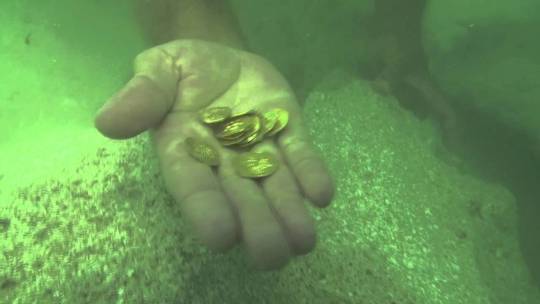

Throughout the investigation, the Florida Fish and Wildlife Conservation Commission worked closely with historical preservation experts to authenticate and appraise the recovered coins sold by Schmitt.
Schmitt is facing charges for dealing in stolen property, the release says.
The company commissioned to salvage the shipwreck said in a statement it “was shocked and disappointed by this theft and has worked closely with law enforcement and the state of Florida regarding this matter.”
“We take our responsibilities as custodian very seriously and will always seek to enforce the laws governing these wrecks,” the statement read.
Recovered artifacts will be returned to their rightful custodians, the news release said. But the investigation is far from over: 13 coins remain missing.

#$1 Million Worth of Gold Coins Stolen From 18th-Century Shipwrecks Found#1715 Fleet shipwrecks#gold#gold coins#collectable coins#treasure#shipwreck#ancient artifacts#archeology#archeolgst#history#history news#ancient history#ancient culture#ancient civilizations
16 notes
·
View notes
Text

A Diet of Deadly Plastic by Justin Gilligan, (Australia) - This image creates a mosaic from the 403 pieces of plastic found inside the digestive tract of a dead flesh-footed shearwater. Gilligan has been documenting Adrift Lab’s work for several years, often joining them on beach walks at dawn to collect dead chicks. The team brings together biologists from around the world to study the impact of plastic pollution on marine ecosystems. Studies found that three quarters of adult flesh-footed shearwaters breeding on Lord Howe Island – and 100% of fledglings – contained plastic. -Photograph: Justin Gilligan/2024 Wildlife Photographer of the Year
Click source for more 2024 Wildlife Photographer of the Year winners' photos
#australia#dead flesh-footed shearwater#procellariiformes#ardenna carneipes#plastic pollution#ingested plastics#justin gilligan#2024 wildlife photographer of the Year competition winners
2 notes
·
View notes
Text

Algunas imagenes a concurso en el Wildlife Photographer of the Year 2024.
12 notes
·
View notes
Text

The Swarm of Life by Shane Gross (Canada) This winning image looks under the surface layer of lily pads as a mass of western toad tadpoles swim past. Western toad tadpoles swim up from the safer depths of the lake, dodging predators and trying to reach the shallows, where they can feed. The tadpoles start becoming toads between four and 12 weeks after hatching. An estimated 99% will not survive to adulthood Photograph: Shane Gross/2024 Wildlife Photographer of the Year
Robert Scott Horton]
* * * *
“Hold this thought: Right when you are most defeated—suicidal, perhaps—exhausted, positive of perpetual failure: this is when the epiphany is likely to arrive. One needs to be beaten down to think, and to think so as to escape. To escape death or boredom or the second act that simply will not do as you wish. Or the marriage that is stalled. Whatever is bearing down on you is a great teacher. Calm down and listen and crawl from beneath it a better person.”
—Harold Pinter/Interview with James Grissom/1997
[follies of god]
#Biology#Shane Gross#wildlife#tadpoles#lily pads#toads#photography#quotes#Harold Pinter#follies of god
18 notes
·
View notes
Text
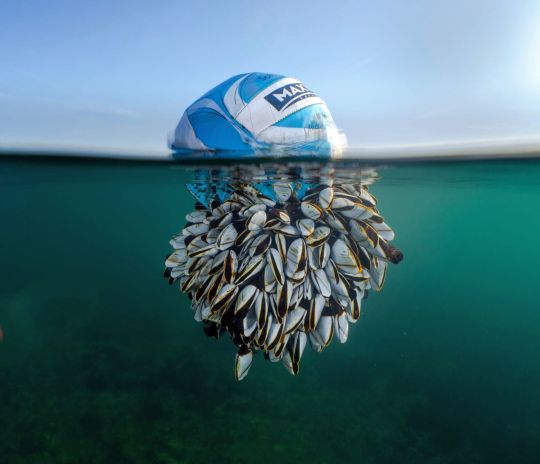
Ryan Stalker, “Ocean Drifter.” British Wildlife Photographer of the Year 2024 and Winner of Coast & Marine category. Goose barnacles (Thoracica), Portland, Dorset, England. All images © the photographers and British Wildlife Photographer of the Year.
29 notes
·
View notes
Text

The more connect I am to nature, the more human I become.
The winner of the animal portraits category frames a lynx resting, with its fully grown young sheltering from the cold wind behind it. Marriott had been tracking this family group for almost a week, wearing snowshoes and carrying light camera gear to make his way through snowy forests. When fresh tracks led him to the group, he kept his distance to make sure he didn’t disturb them. With climate change reducing snow coverage, giving other predators more opportunities to hunt hares, hare populations may decline, in turn affecting the lynx population
Photograph: John E Marriott/2024 Wildlife Photographer of the Year / Courtesy Guardian Newspaper
9 notes
·
View notes
Text

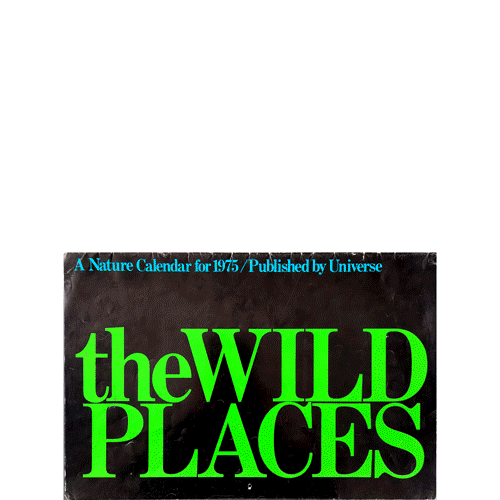

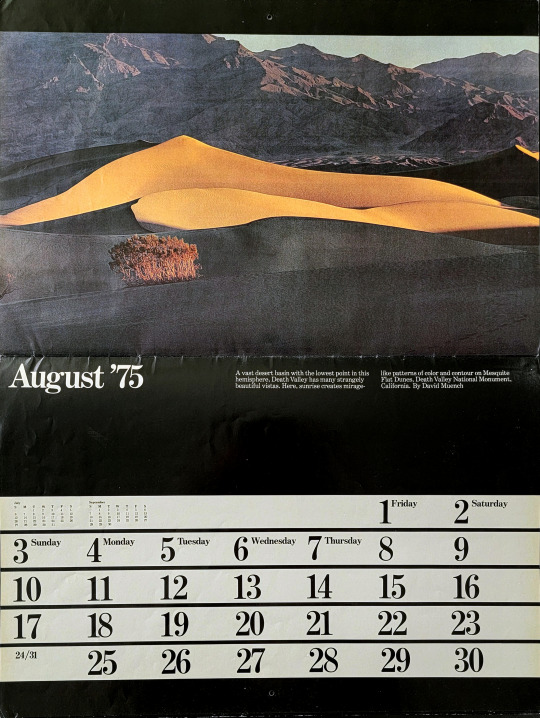
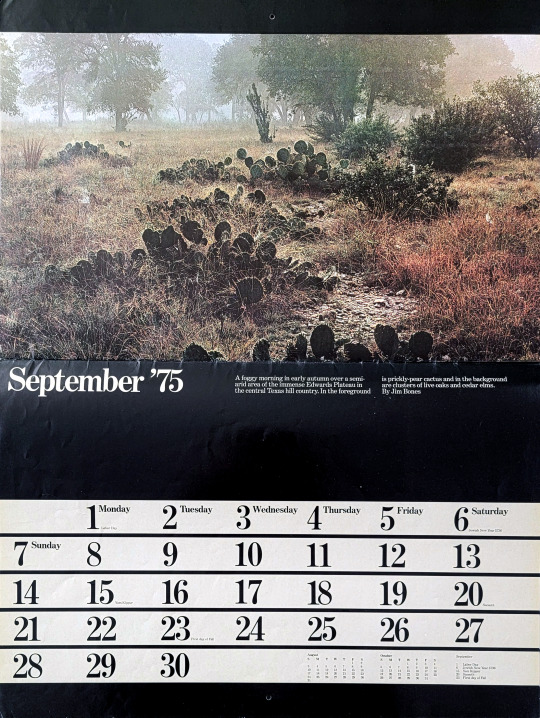
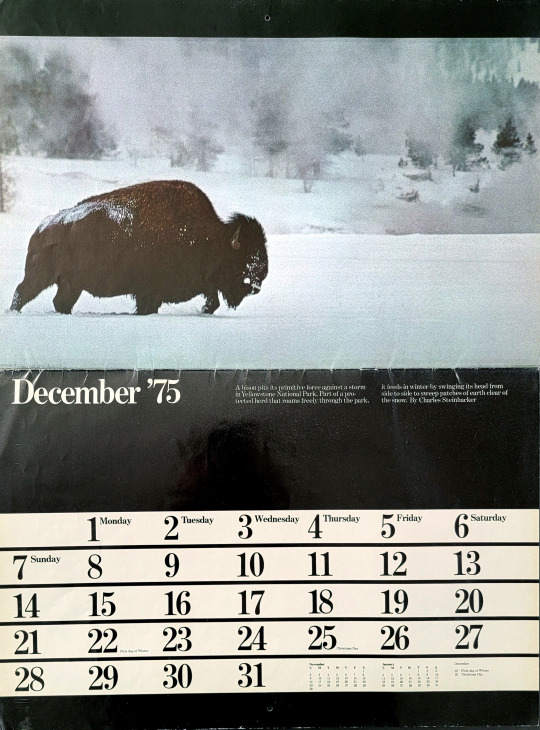



Happy 2024!
We're celebrating the new year with some deep cuts from the Vignelli archives: 1970s calendars
Our first pick is the 1975 the Wild Places calendar
Design: Massimo Vignelli.
Text from the calendar:
The photographs in this calendar appeared in the book The Wild Places: A Photographic Celebration of Unspoiled America. [note: the book was also designed by Vignelli]
This matchless collection of photographs, drawn from a superb book, The Wild Places, is inspiring evidence that the remaining wildlands and wildlife of America are as breathtaking as ever.
Covering the continent from ice-strewn Alaskan tundra to the Southwestern desert and from a bird on a Maine island to a great Florida swamp, they reveal the wonder and mystery of untouched wilderness.
Eight of America’s leading photographers are represented her by their outstanding works, ranging from Eliot Porter’s winter wren, David Muench’s Painted Desert scenes and Charles Steinhacker’s bison in a storm to James Bones’ view of a Texas plateau. This is a calendar for anyone who cherishes the miracle that is nature and believes Thoreau that “wilderness is the preservation of the world.”
Published by Universe Books, New York. Prepared and Produced by Chanticleer Press, Inc., New York. Printed by Amilcare Pizzi, S.p.A. Milan, Italy.
25 notes
·
View notes